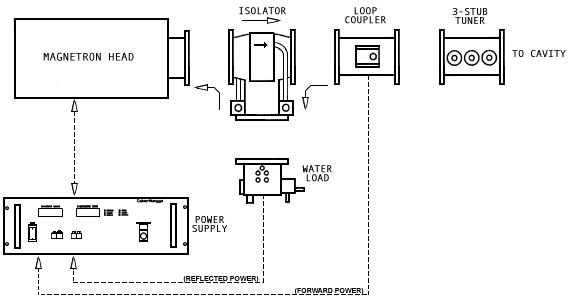At CoberMuegge LLC, we have been involved in the design and configuration of a large number of microwave heating systems. This experience has led us to develop a set of recommendations for the  components necessary to configure a successful system. components necessary to configure a successful system.
At one end of the system is the microwave power source. The major considerations in selecting the power source are: power level needed, cost, method of control, power supply ripple level and, form factor. It is generally a straightforward decision to select an appropriate power source once the requirements are defined.
At the opposite end of the system is the load. Questions to be considered for this end of the system are: cavity type (multi-mode vs. resonant), applicator required, size, etc. These are the areas given the most study by those designing a system. Most applications make use of a general purpose, multi mode oven cavity of an appropriate size that may include such features as a mode stirrer, turntable, instrumentation, etc. Purpose-built applicators or cavities are also used. These are, obviously, specific to a particular application and may require extensive design and testing.
The connection between the source and the load is the area that is most often neglected in the design of the system. In our experience, successful systems usually consist of some or all of the items listed below.

-
Power Source.
-
Isolator (circulator plus dummy load).
-
Directional coupler with power readout device(s).
-
Appropriate waveguide pieces of proper length and geometry.
-
Tuner.
-
Load (cavity).
An isolator, which is a circulator plus a dummy load, is often employed directly after the power source in order to protect the magnetron from excessive levels of reflected power. Power reflected back to the magnetron can cause overheating and moding. This can result in reduced efficiency and shortened tube life. The use of an isolator is a good safety precaution to take and becomes increasingly important as the power levels increase. For power levels of 2 kW and below, an isolator is usually not necessary. For power levels between 2 and 6 kW, an isolator is recommended but not a requirement. For power levels of 6 kW and above, an isolator should be considered a requirement.
A directional coupler is a useful device to include in the waveguide run. Most often the device is used with an appropriate detector and meter to measure reflected power. It can also be used to measure forward power, or, in fact, power in both directions depending upon the device chosen. In some systems the power source or isolator includes provision for measurement of reflected power and a directional coupler is not needed. Some means of measurement of forward and, particularly, reflected power is needed when employing a tuner (see discussion below).
Additional pieces of waveguide may be required to connect the power source to the load. This is, clearly, determined by the relative locations of power source and load.
The final device prior to the load in any system should be a tuner of some type. A tuner is used to match the impedance of the load with the impedance of the source. In practice, with power to the system and a load in place, the tuner is adjusted to minimize the reflected power level. This results in the most efficient use of the microwave power supplied and has the additional benefit of minimizing reflected power back to the magnetron. Tuners are available in a number of different styles depending upon the type of system being used. CoberMuegge will be pleased to help you select the proper device for your application.
In our experience, following the guidelines given above will result in a system which will not only perform well, but also perform reliably for a long time. CoberMuegge LLC and the experts at our parent organizations are prepared to assist you in determining the best configuration for your application. Let us put our experience to work for you.
|









